11 Best AI Music Generators for 2025 (Top Picks)
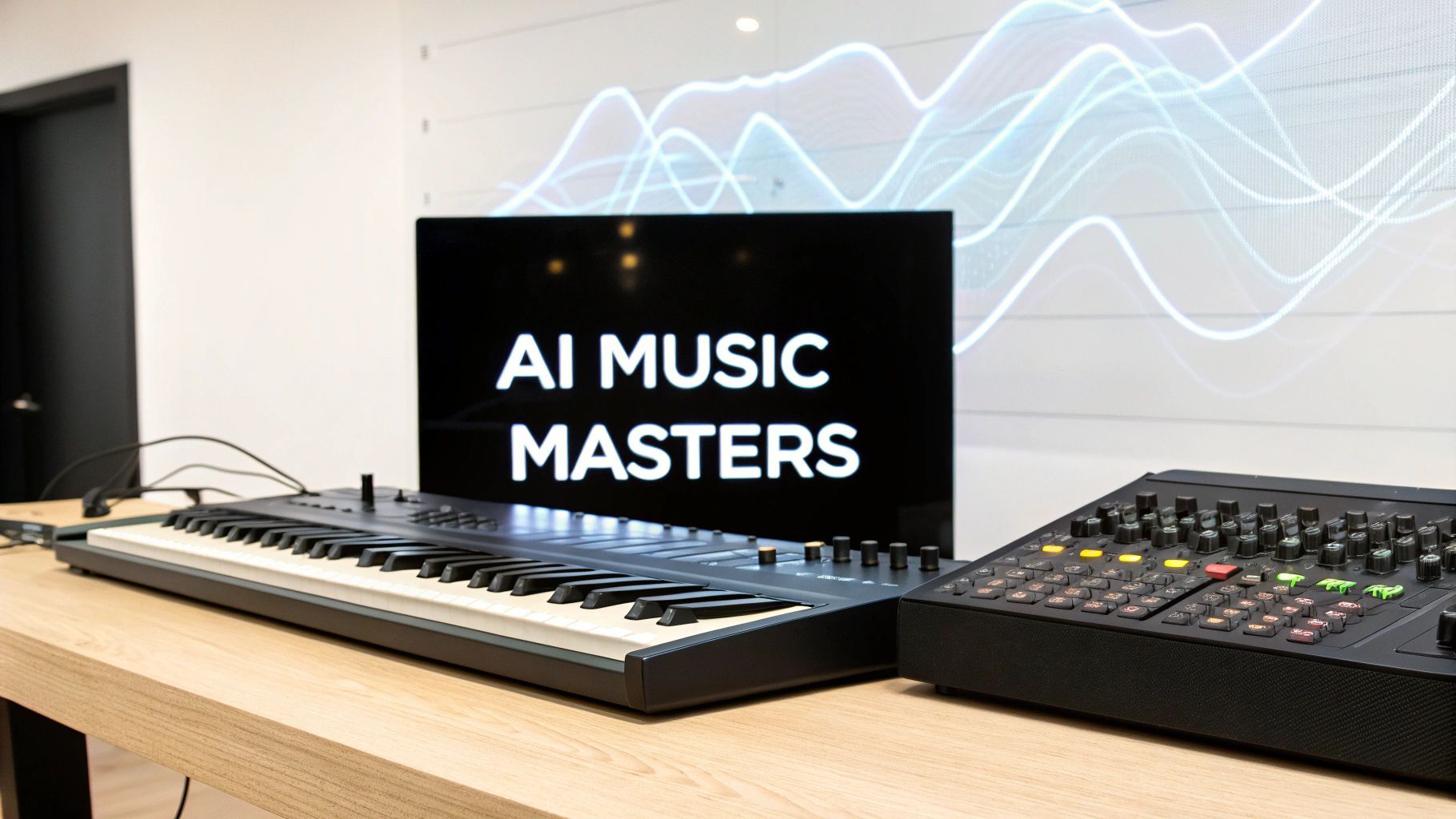
Video Gen Now Faster & Cheaper!


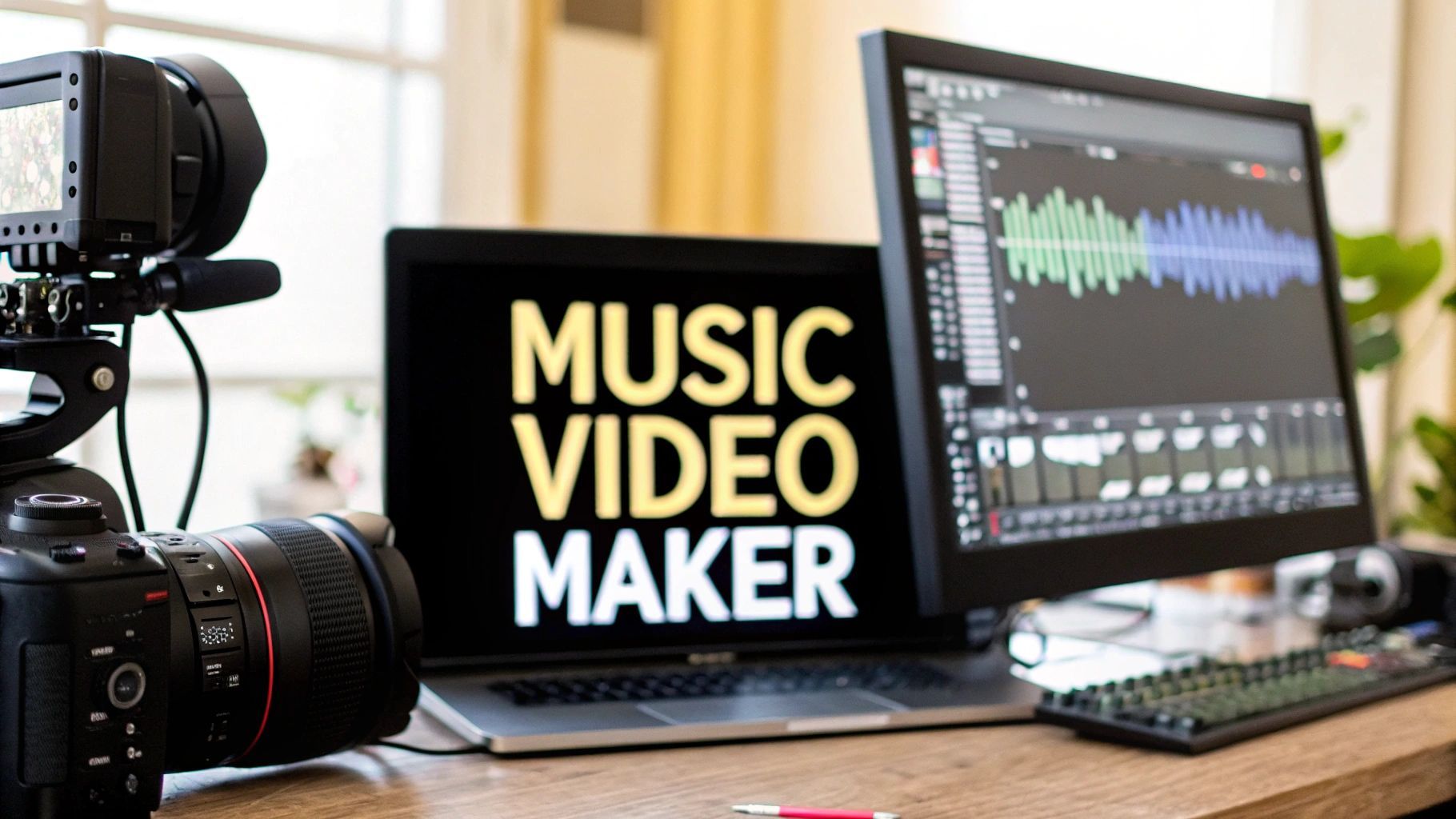
Unleash your creativity with an AI music video maker. This guide breaks down how to turn your songs into stunning videos without a huge budget or crew.
So, what exactly is an AI music video maker? Think of it as your personal, on-demand director and animation team, all rolled into one clever piece of software. It’s a tool that listens to your track and—using the magic of artificial intelligence—spits out a fully realized music video in just a few minutes.
This isn't about slapping random stock footage over your song. We're talking about a genuine creative partner that helps you craft something visually stunning without the headaches of a traditional video shoot. Forget needing a massive budget, a film crew, or years of editing experience.
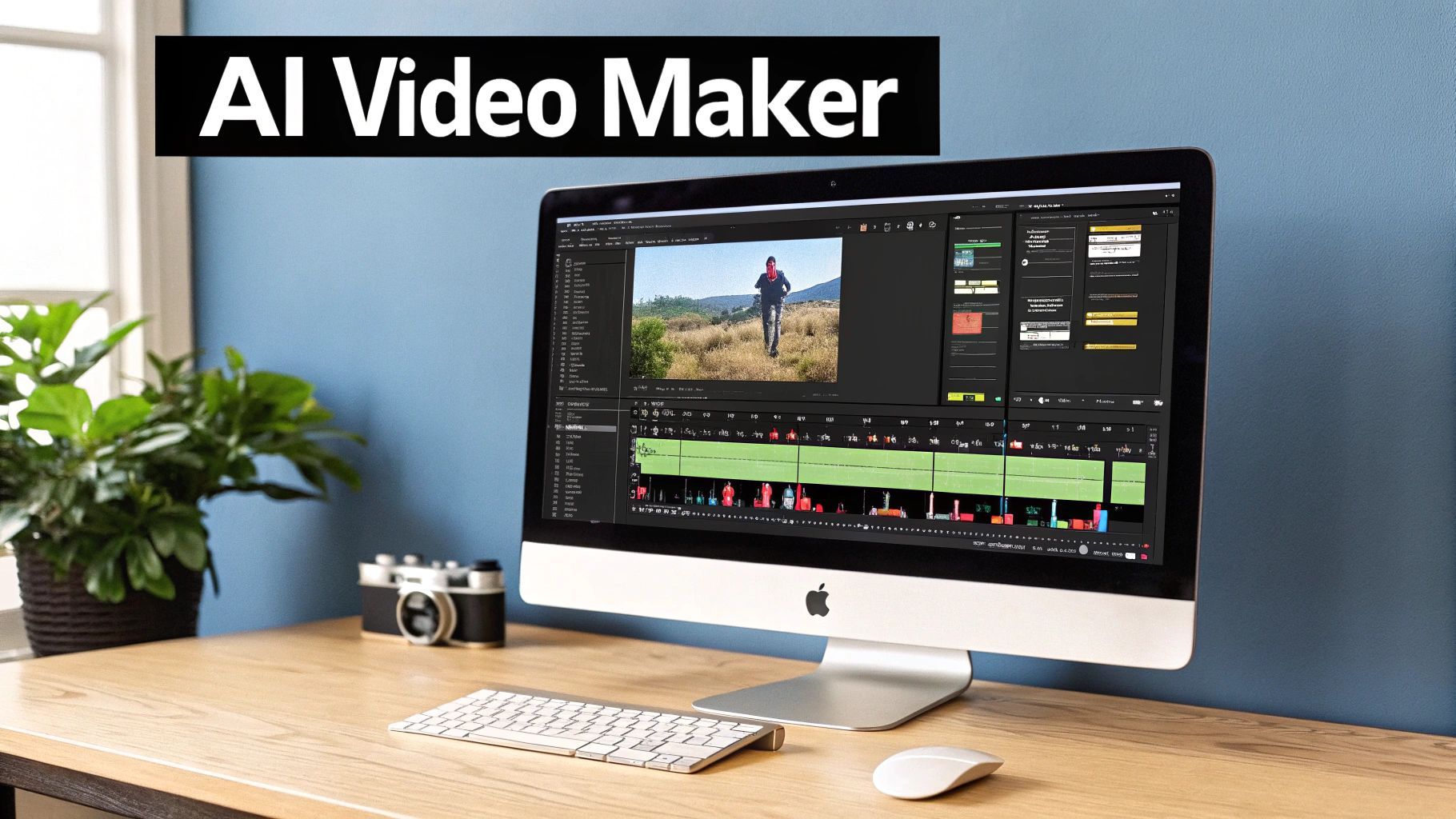
Let's be real: for years, a high-quality music video felt out of reach for most independent artists. The walls were high—cost, time, and the sheer technical know-how required. Well, consider those walls officially bulldozed by AI.
This isn't just some flashy new tech trend; it's a fundamental shift in how artists can express themselves. An AI music video maker is more than a tool; it's a new instrument. It’s your chance to take the wild, ambitious concepts in your head and make them real, fast.
You might be wondering if the AI just throws random cool-looking scenes together. Nope. The good ones are much smarter than that. They're built to dissect the very soul of your music and translate it into visuals that make sense.
Here’s a peek under the hood at what the AI is listening for:
Rhythm and Tempo: The AI syncs the beat of your song to the video's pacing. Fast-paced tracks get quick cuts and dynamic motion, while a slow ballad gets long, flowing shots. Mood and Tone: Is your song a heartbroken acoustic number or a high-energy dance anthem? The AI picks up on that vibe, generating color palettes and imagery to match—think dark, moody blues for a sad song or vibrant neons for a party track. Instrumentation: It can even identify specific sounds. That ripping guitar solo might become a flash of electric energy, while a dreamy synth pad could morph into a swirling, cosmic vista.
This kind of analysis means the final video feels intentionally crafted, not just randomly assembled. It's a key part of the modern content creation workflow that's giving power back to creators.
The whole point is to put you in the director's chair without the insane costs and crew management. You provide the vision, and the AI handles the grunt work.
This isn't happening in a vacuum. The entire music and video market, supercharged by AI, is expected to skyrocket by a mind-boggling USD 875 billion between 2024 and 2028. Why? Because as more people get online, they’re hungry for more content to stream, and AI is making it possible to meet that demand.
Here's a quick breakdown of how using an AI music video maker stacks up against the old-school approach.
Factor AI Music Video Maker Traditional Production Cost A tiny fraction of traditional costs, often subscription-based. Can easily run from $5,000 to $50,000+. Time Minutes to a few hours. Weeks or even months of planning, shooting, and editing. Skills Needed Basic computer skills and a creative idea. Requires a director, cinematographer, editor, and more. Creative Control High-level control over style, theme, and pacing. Absolute control, but requires a skilled team to execute. Logistics Zero. Create from your laptop anywhere in the world. Location scouting, permits, crew, and equipment rentals.
Ultimately, both paths have their place, but it's clear which one opens the door for more artists to create.
At the end of the day, an AI music video maker lets you get back to what you do best: making music and telling your story.
Ready to see for yourself? Our own AI video generator is a great place to start turning your audio into something incredible.
Alright, let's ditch the robotic vibe and talk like real people making cool stuff. Before you dive headfirst into the SendFame Music Video Maker, you've got to get your ducks in a row. It’s a bit like laying out all your ingredients before you start cooking—it just makes the whole process smoother and way more fun.
Think of this as your pre-production phase. Getting this part right is the secret sauce to making a video that actually feels like your art, not just something a computer spat out.
The absolute first thing you need is your track, and quality is king here. Seriously. Feeding the AI a crummy, low-res MP3 is like asking a master painter to work with muddy water. It’s just not going to work out. You need a clean, high-resolution audio file—we're talking a WAV or at least a 320kbps MP3.
This gives the AI enough sonic detail to really listen to your music. It can pick up on the subtle shifts in energy, the punch of the kick drum, and the emotional arc of your melody, all of which are crucial for creating visuals that feel perfectly synced up.
Okay, you've got your killer track. Now, what's the story? And I don't mean a full-blown Hollywood script. I mean, what's the feeling?
Close your eyes. Put your headphones on. Play your song. What pops into your head?
Is it a raw, black-and-white visual for a stripped-down acoustic song? Maybe it’s a trippy, kaleidoscopic journey for a psychedelic rock anthem? Or are you seeing a rain-soaked, neon-lit cityscape for a moody synth track?
Scribble it all down. No idea is too weird at this stage. You're not writing prompts yet; you're building a world. You're creating a visual mood board in your head that will guide every decision you make from here on out.
Don’t skip this part. This is where you inject your soul into the machine. It’s the difference between you being the director and the AI just making a generic, soulless video. Your vision is what makes it unique.
There’s a reason this space is blowing up. The whole AI video generator market is rocketing from around $1.08 billion in 2025 to a projected $2.0 billion by 2030. That growth is happening because the tech is getting incredibly good at understanding and executing on human creativity. If you want to dive deeper, you can check out the full AI video generator market report.
Got your vibe figured out? Awesome. Now let's gather some concrete inspiration. This is how you'll translate that feeling in your head into clear instructions for the AI.
Go on a Visual Scavenger Hunt. Hop on Pinterest, Behance, or even just Google Images. Search for things that match your vibe and start saving them. These references are your visual language. They help you pinpoint the exact colors, textures, and lighting you're after. Become a Word Collector. Look at the images you saved. How would you describe them? Words like “ethereal,” “grimy,” “sun-drenched,” “vintage film,” and “cyberpunk” are pure gold. These are the powerful keywords that will shape your AI prompts. Think Like a Cinematographer. How do you want the camera to move? Is it a slow, cinematic pan across a landscape? Or a frantic, shaky-cam shot that follows the action? Jot down terms like “slow-motion push-in,” “sweeping drone shot,” or “dynamic orbiting shot.”
When you walk into the ai music video maker with your high-quality track, a clear concept, and a folder full of visual references and keywords, you're not just hoping for a good result. You're engineering one. It makes the creative process faster, less frustrating, and a whole lot more rewarding.
Alright, let's get into the good stuff. This is where you put on your director's hat and start bossing the AI around. You're not just an artist anymore; you're the cinematographer, the set designer, and the visual storyteller, all rolled into one. Learning to write prompts for an AI music video maker is like learning a new language—a creative shorthand that turns your musical ideas into something people can see.
Think of it this way: your words are the paint, and the AI is your canvas. The more vivid and specific your descriptions are, the more jaw-dropping the final video will be. Throwing a simple prompt at the AI will get you a simple, probably boring, result. But when you start weaving in details and layering ideas? That’s when the magic really happens.
If you just type "a sad video for my slow song," you're going to get a snoozefest of generic, sad-looking clips. Yawn. But what if you could describe the texture of that sadness? What if you could direct the entire scene with surgical precision?
Let's look at the difference a few good words can make:
The Bland Prompt: A sad, lonely person walking. The Director's Prompt: A solitary figure trudges down a rain-slicked city street at midnight, the glow of neon signs reflecting in oily puddles. Cinematic, moody lighting, shot in dramatic slow-motion.
See? The second one doesn't just say "sad." It builds an entire world. It gives the AI a specific time of day, weather, lighting cues, and even camera instructions. This is the secret sauce to making the AI work for you.
This whole process is about turning your audio file into a full-blown visual experience, with your prompts acting as the bridge.
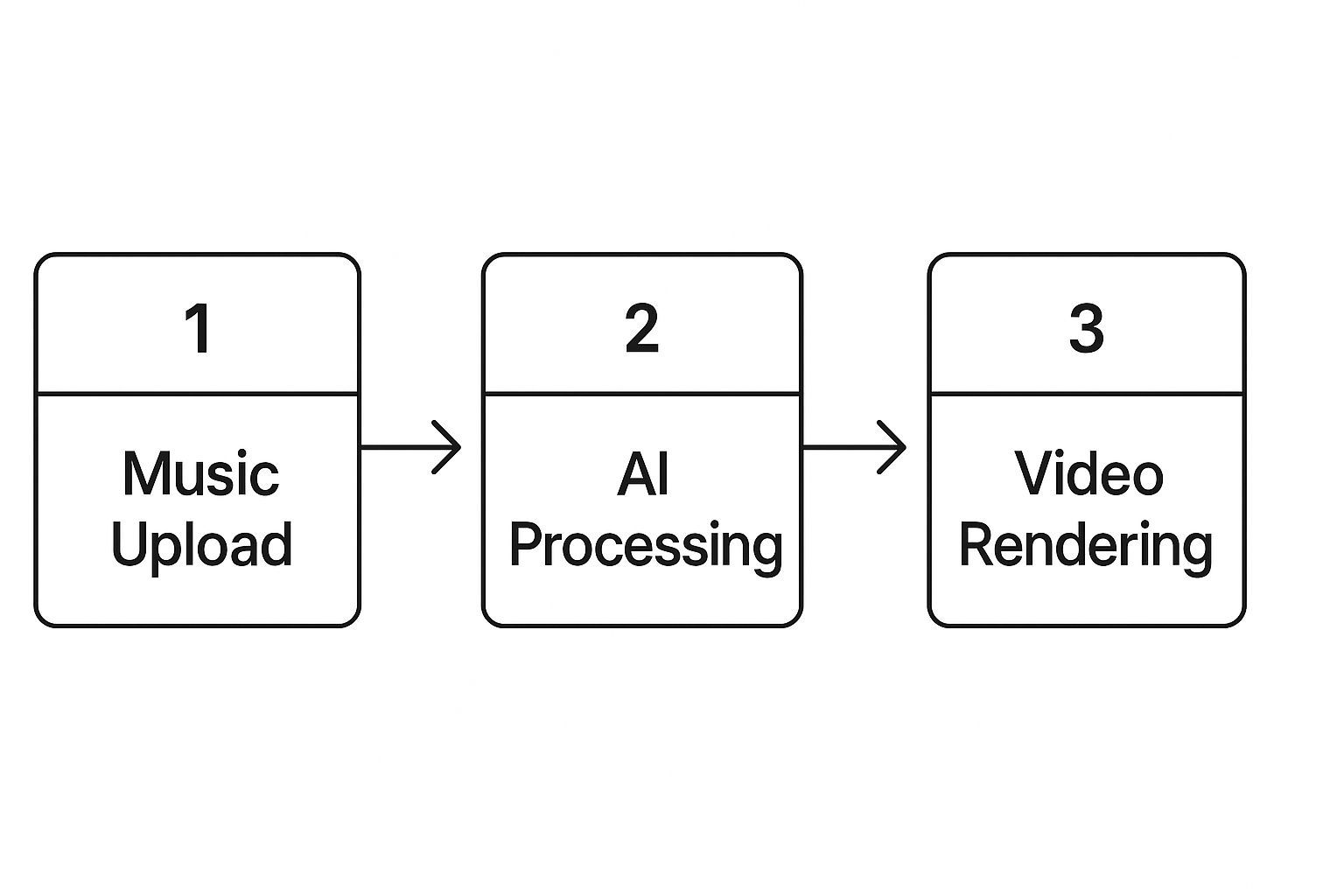
The big takeaway is that your creative brainpower—the prompts you write—is what guides the AI. You're the one in control.
For consistently awesome results, I like to think in layers. Start with the big picture and then drill down into the details. Here’s a little recipe I use to cook up powerful prompts:
Subject & Action: What's the main event? Let's say, A wolf is howling at a full moon. The Setting: Where's this all going down? In a misty, ancient forest shrouded in fog. The Vibe & Style: What should it feel like? Surrealist oil painting, in the style of Salvador Dalí. Camera Work: How are we seeing this? Dynamic orbiting shot, from a low angle, looking up.
Now, string it all together: A wolf howls at a full moon in a misty, ancient forest. Surrealist oil painting, in the style of Salvador Dalí. Dynamic orbiting shot, from a low angle. That single sentence is packed with everything the AI needs to create something truly special.
My Favorite Tip: Get weird with it! Seriously. Don't be afraid to throw some curveballs. What happens when you ask for "grainy 90s camcorder footage of a futuristic cyber-dragon"? Or "a vibrant underwater rave made of candy"? The most unique and exciting visuals come from pure experimentation.
If you hit a creative wall or just can't find the right words, remember that you can get help by utilizing AI tools like ChatGPT for prompt generation. It's like having a creative partner to bounce ideas off of and find new ways to describe your vision.
To give you a head start, here’s how you might tailor your prompts for different kinds of music. The keywords you choose can completely change the mood.
Music Genre Core Keywords Style Modifiers Example Prompt Snippet Hip-Hop / Trap Cityscape, chains, luxury car, neon, graffiti Gritty, high-contrast, fast cuts, low angle A sleek black sports car cruising through a neon-lit downtown at night, high-contrast, lens flare... Indie / Folk Sun-drenched field, vintage dress, acoustic guitar Golden hour, soft focus, film grain, handheld shot A woman with a guitar in a sun-drenched wheat field, 16mm film grain, warm nostalgic glow... EDM / Electronic Abstract shapes, geometric patterns, laser lights Pulsating, strobing, psychedelic, kaleidoscopic A kaleidoscopic tunnel of pulsating neon geometric shapes, synced to the beat, strobing lights... Heavy Metal Fire, skulls, stormy sky, mythological beasts Epic, dark, cinematic, slow-motion, dramatic lighting A Viking warrior standing on a cliff during a thunderstorm, lightning flashes, epic cinematic scale...
Thinking about your genre's aesthetic is a great shortcut to finding the right visual language for your track.
By the way, this whole skill of "speaking AI" is incredibly useful beyond just video. If you're creating the music itself, the same principles apply. We dive deeper into how this works in our guide to the SendFame AI music generator, showing you how to craft entire songs just by describing them.
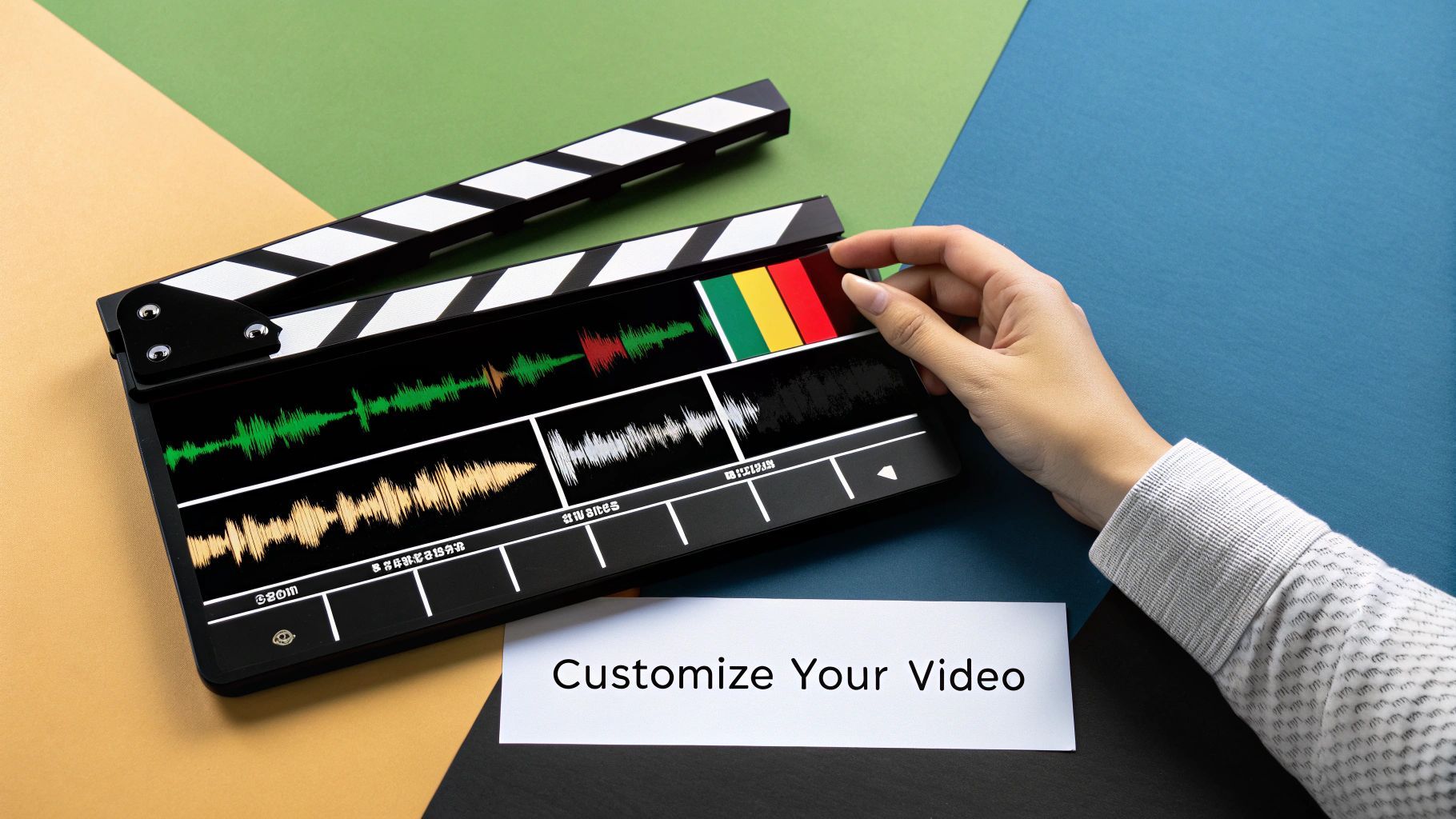
Alright, you’ve hit the big, beautiful "generate" button. The rush is real. But let's be honest, that first cut from any ai music video maker is rarely the final cut. It’s your starting block, not the finish line. The true magic happens now, in the editing room—even if that "room" is just you and your laptop.
This is where you get to put on your director’s hat and shape the AI's raw output into something that feels intentional, artistic, and emotionally connected to your music.
Think of this as a cycle, not a one-and-done task. You're going to watch, critique, and tweak until it feels right. Nobody gets a masterpiece on the first go, and that’s part of the fun. This hands-on process is what makes a video truly yours.
The best way I've found to tackle this is to break your song down into its core components: intro, verse, pre-chorus, chorus, bridge, outro. Now, watch your generated video with a laser focus on each section.
The Intro: Does that first shot immediately pull you into the world of the song? The Verses: Are the visuals telling the same story your lyrics are? The Chorus: Bam! Is this the most visually powerful, high-energy part of the video? It should be. The Transitions: How does it feel moving from a quiet verse to an explosive chorus? Is it an exciting jump or a clumsy stumble?
If a scene feels off, don't throw the baby out with the bathwater. Pinpoint the weak spot. Let's say your chorus visuals are a bit… meh. Go back to the prompt you wrote for that specific part. It might be as simple as adding more powerful keywords like "dynamic fast cuts," "explosive energy," or "epic aerial shot" to give the AI a better jolt of inspiration. Then, just regenerate that single section.
Key Takeaway: This review-tweak-regenerate loop is the secret sauce. You’re essentially collaborating with the AI, guiding it clip by clip until it brings your vision to life. Embrace the back-and-forth!
What if a scene is so close but not quite there? This is where you can get clever with the AI's settings.
One of my favorite tricks is playing with the "seed" number. Think of a seed as the unique starting point for the AI's generation. If you use the exact same prompt but change the seed number, you'll get a slightly different result—maybe a different camera angle, a subtle shift in character movement, or a change in the background. It’s a fantastic way to get a few different "takes" of the same idea.
Let's imagine you prompted a shot of a singer in a forest, but they look kind of bored. Don't ditch the idea; refine the instructions.
Original Prompt: A singer in a forest. Refined Prompt: A singer in a lush, ancient forest, singing with passionate and heartfelt emotion, cinematic lighting.
See the difference? You’re giving the AI much clearer emotional and stylistic direction. The more specific you are, the better the result.
Understanding how different platforms respond to these nudges is crucial. Our guide on the best AI video generator tools breaks down which ones offer the most granular control. Knowing your tool's strengths is a huge advantage during this fine-tuning stage. Keep experimenting until every frame feels like it belongs.
Alright, you've got a folder full of incredible AI-generated clips. They look slick, but let's be real—the job isn't quite finished. An ai music video maker is a phenomenal tool that gets you 90% of the way there, but that final 10%? That’s where the magic happens. It’s the human touch that transforms a cool tech demo into a genuinely professional music video.
Think of your AI footage as perfectly prepped raw ingredients. Now, it's time to be the chef. You’ll want to pull everything into a simple video editor. Don't sweat it if you're not a Hollywood editor; free and user-friendly tools like CapCut or the powerful DaVinci Resolve are more than enough to handle these finishing touches.
First things first: brand it. Drop your artist name and song title onto the video using clean, stylish text. It’s a small detail that makes a massive difference, instantly adding a layer of legitimacy and making sure everyone knows who created the awesome track they're hearing.
One of the quirks of working with AI is that even with perfect prompts, you can end up with scenes that feel a bit disconnected from each other. The easy fix? A little color grading. Applying a consistent color filter or a LUT (Look-Up Table) across all your clips is like putting a fresh coat of paint on a house—it instantly ties everything together. Suddenly, every scene looks like it was shot for the same project.
This is also your chance to mix things up. Got some B-roll of you performing, even if it's just from your phone? Perfect. Splicing that live-action footage between the AI scenes creates a killer hybrid video. It grounds the surreal visuals with a dose of authentic, human energy that audiences love.
Pro Tip: When you’re blending live-action and AI clips, think about matching the energy, not just the visuals. A frantic, high-energy AI scene should cut to an equally dynamic performance shot. This keeps the momentum rolling and makes the whole edit feel deliberate and powerful.
If you want to dive deeper into these editing techniques, our guide on how to create stunning music videos is packed with tips that work for both AI and traditional videos. It's a goldmine for leveling up your final product.
Before you smash that export button, take a second to think about where this video is going to live. Every social media platform is its own little world with its own rules, and tailoring your video for each one is key to getting noticed.
YouTube: The home of traditional music videos. You’ll want a widescreen 16:9 aspect ratio. Export in the highest quality you can, at least 1080p, to look sharp on everything from phones to big-screen TVs. Instagram Reels & TikTok: Welcome to the vertical universe. This is where you re-edit your project into a 9:16 format. Think quick cuts, big visuals, and grabbing attention in the first three seconds. Instagram Feed: The classic square (1:1) is still a powerhouse here. It takes up a ton of screen real estate as people scroll, ensuring your video doesn't get lost in the noise.
Once your masterpiece is exported and ready, the next step is getting it seen. Understanding the strategies for creating viral videos can give your music the launchpad it deserves. Taking care of these final details ensures all your creative work pays off, captivating viewers on every screen.
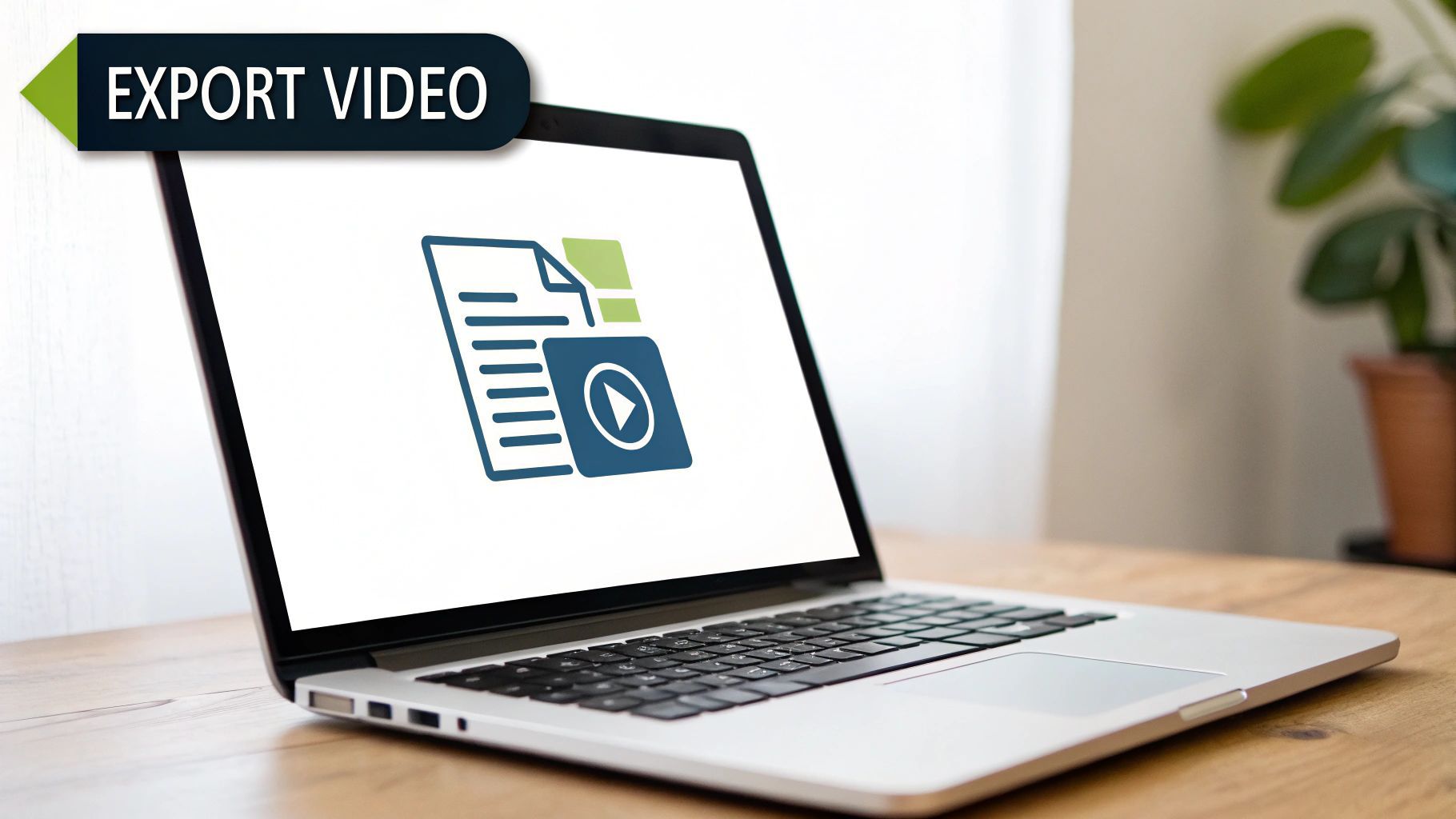
Diving into AI creativity for the first time? It's totally normal to have a few questions buzzing around. Honestly, who wouldn't? This stuff is wild. We get tons of DMs and emails from artists just like you, so we’ve put together a quick rundown of the big ones.
Heck yes! In fact, you absolutely should. While the AI is a wizard at cooking up mind-bending visuals, the truly killer videos are the ones that mix AI scenes with your own footage. Platforms like SendFame are built for this.
Think of it as the ultimate mashup. You can drop in your performance shots to ground the video in reality, then cut to an insane AI-generated world. That contrast? That’s what makes your video pop and feel like yours.
Pro Tip: Try this combo: a super clean, simple shot of you singing, followed immediately by a chaotic, colorful AI explosion. It’s a trick that grabs attention and doesn't let go.
This is the million-dollar question, and the answer is simple: you have a ton of control. You're the director here. The AI is your tireless production crew, but you’re the one calling all the shots.
Your prompts are everything. They set the mood, the style, the color, and the action. The AI is powerful, but it's waiting for your command. You’re not just pressing a button; you're collaborating with a tool that executes your vision.
That's a huge reason the AI music scene is blowing up. We’re talking a $2.9 billion market in 2024, projected to skyrocket to $38.7 billion by 2033. If you want to dive deeper into the numbers, there's some wild data about the growth of AI in the music industry.
This is a big one, and it's non-negotiable. With a solid ai music video maker like SendFame, the final cut is 100% yours. You own the copyright.
That means you can upload it to YouTube, splash it all over TikTok and Instagram, and use it in your press kit without a second thought. No copyright strikes, no weird restrictions.
Just be smart and always give the terms of service a quick scan on whatever platform you use. The good ones are designed to put the power in your hands, not tie them up in red tape.
We've covered some of the most common questions artists have when they're first exploring AI tools. To make things even clearer, here’s a quick-reference table.
Question Answer How long does it take to make a video? It varies, but you can get a first draft in minutes, not days. Tweaking and perfecting it might take a few hours, depending on how detailed you get. Do I need video editing skills? Not at all! The best tools are designed to be super intuitive. If you can write a descriptive sentence, you can direct an AI video. Is the video quality good enough for YouTube? Absolutely. Most AI video makers, including SendFame, export in high-definition formats perfect for YouTube, Vimeo, and social media. Can I match the video to my song's BPM? Yes, many tools offer beat-matching features that analyze your audio and sync the visual cuts and transitions to the rhythm of your track.
Hopefully, that clears a few things up! The best way to learn is by doing.
Ready to stop wondering and start creating? The only way to really get it is to jump in and see the magic happen. The SendFame Music Video Maker is ready and waiting to turn your sound into a spectacle. Give your first project a shot!
Create Epic
SendFame